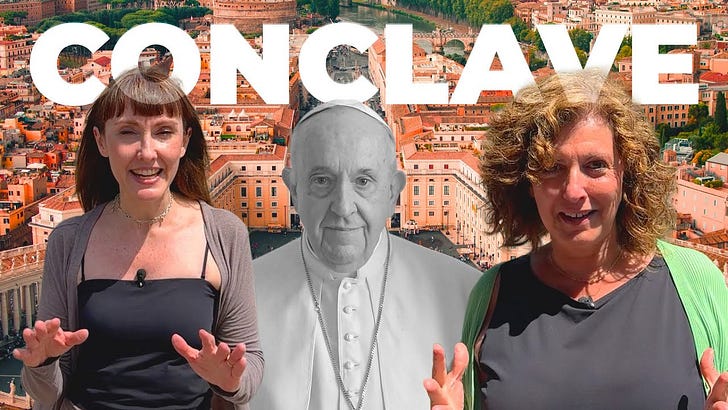Wow, the past 10 days have been quite eventful — and there’s more to come. While we knew Pope Francis wasn’t in perfect health, his passing on April 21 still came as a surprise. On April 26, leaders and royalty from around the world gathered in Rome to attend his funeral.
Pope Francis was Pope number 266.
Now, the Catholic Church begins the process of electing Pope number 267 — and it’s one of the most structured, sacred, and secretive rituals in the world.
And that takes us to another important date that will mark history: 7 May 2025, the day the election of the new Pope begins.
Thanks to the latest movie hit, many of you now also know what it’s called: the Conclave. Let’s break it all down.
Who Is the Pope?
The Pope wears many hats:
1️⃣ He is the leader of the Catholic Church, which is the oldest and largest Christian organization in the world. It has over 1 billion members and traces its roots back to Jesus and the Apostles. According to Catholic belief, Jesus appointed Peter as the leader of his followers. Peter was the first Pope — Pope Francis was number 266.
2️⃣ He is also the Bishop of Rome, a position that gives him authority over the Church in the city.
Fun fact: the official seat of the Bishop of Rome is not St. Peter’s Basilica but San Giovanni in Laterano.
3️⃣ Finally, he’s the head of Vatican City, the smallest country in the world, right inside the city of Rome. Vatican City was officially established as an independent nation in 1929 and is home to the Pope, St. Peter’s Basilica, the Vatican Museums, and the Sistine Chapel.
What Happens When a Pope Dies?
When a Pope dies — or resigns, like Pope Benedict XVI did in 2013 — the Church enters a period called Sede Vacante (“the seat is vacant”).
During this time:
All official Church matters pause.
A senior Church official called the Cardinal Camerlengo takes charge of day-to-day operations.
All cardinals under the age of 80 are summoned to Rome to prepare for the election of a new Pope.
Who Gets to Vote?
Only cardinals under the age of 80 can vote.
Cardinals are bishops who have been appointed by a Pope as his most senior advisors. To simplify the Church hierarchy:
The Pope is at the top.
Cardinals come next — they wear red and help govern the Church.
Then Archbishops and Bishops — they wear purple and oversee specific regions.
At the local level, you have priests, responsible for individual parishes.
What Is the Conclave?
The Conclave is the official name of the papal election.
The word comes from Latin: cum clave, meaning “with a key.” That’s because, once the Conclave starts, the cardinals are locked in, completely cut off from the outside world. No phones. No internet. Total secrecy.
The Conclave:
Takes place inside the Sistine Chapel.
Usually begins 15 to 20 days after the Pope’s death.
Involves only the cardinals under 80 years old.
Is designed to protect the process from outside influence and ensure the decision is made with full spiritual focus.
The cardinals stay at a Vatican guesthouse called Casa Santa Marta, and they remain in isolation until the new Pope is elected.
How Does the Election Work?
It all begins with a special Mass for the Election of the Roman Pontiff at St. Peter’s Basilica.
After Mass, the cardinals walk in procession to the Sistine Chapel, where they take an oath of secrecy and swear to follow the rules of the election. Then the Master of Ceremonies declares Extra omnes! — Latin for “Everyone out!” — and the doors are closed.
From there, the election takes place by secret ballot.
Each cardinal writes the name of his chosen candidate on a paper ballot. Votes are cast and counted carefully. To be elected, a candidate must receive a two-thirds majority.
Because secrecy is so important, everything that happens inside the Conclave remains confidential. At the end of each voting session, all the ballots — along with any notes — are burned in a special stove inside the Sistine Chapel. That stove is connected to a chimney that rises through the roof of the chapel — and this is where the world looks for a sign.
Black smoke = no Pope yet.
White smoke = a new Pope has been elected.
What Happens After the Vote?
Once a cardinal receives enough votes, he is asked two questions:
“Do you accept your election?”
“What name do you choose?”
If he accepts, he becomes Pope immediately.
He’s then led to the Room of Tears, a small chamber next to the Sistine Chapel. Here, he changes into the white papal garments for the first time — and yes, it’s called the Room of Tears because, well … many new Popes have cried from the emotion.
After a brief prayer, the Conclave ends.
The Announcement
Outside in St. Peter’s Square, the crowd grows, eyes locked on the chimney.
Then comes the moment:
White smoke.
The senior cardinal appears on the balcony of St. Peter’s Basilica and announces:
Nuntio vobis gaudium magnum: Habemus Papam! (“I announce to you a great joy: We have a Pope!”)
He says the Pope’s birth name and the new papal name he’s chosen — a name that often reflects the type of leader he hopes to be.
Then the new Pope steps out and greets the world for the first time, delivering his Urbi et Orbi blessing — "to the city [Rome] and to the world."
Why It Matters
And that’s how the leader of the Catholic Church has been elected for over 700 years.
Whether you're Catholic, another religion, or not religious at all — following the Conclave means watching history unfold in real time.
Because behind the white smoke is not just a new Pope, but a new chapter in global history.
Let’s keep an eye on the chimney together!




